65 - Spanish in the Barrio
Saturday, July 20, 2013
The way I hear it, there are three Spanish languages. And no, I'm not talking about Castiliano, Catalan and Valenciana. Anyway if I was, it'd be a longer list. No, I'm talking about what they don't tell you when you start learning a language.
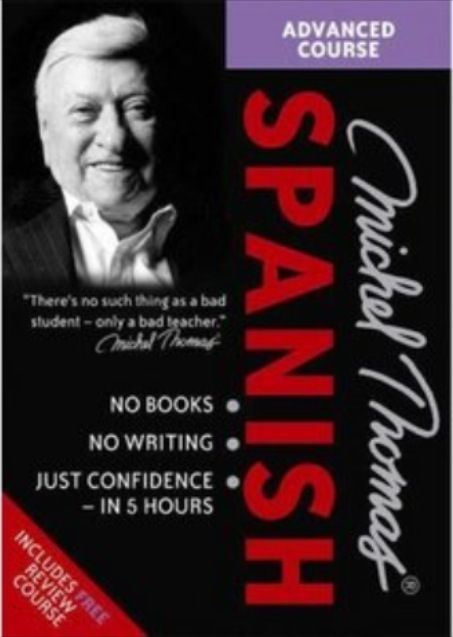 Three Spanish languages. All different. Three Spanish languages. All different.
First - the Spanish on my CDs and all those helpful Learning Zone programmes on at 4am on BBC2. Happy smiling people speaking slowly and clearly, choosing straightforward words, and avoiding "street" colloquialisms. My intercambio (language exchange) partner also speaks this way, though of course only with me. Most importantly, they separate each word from the next. I understand, I participate, and I feel I am making progress.
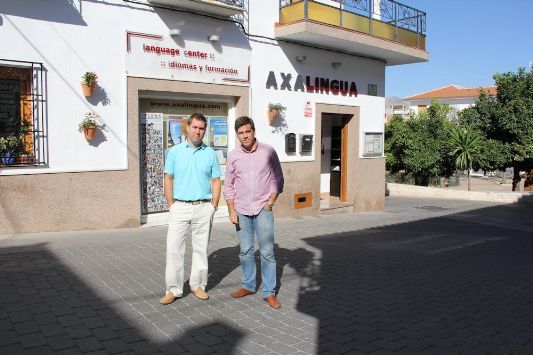 Second - the Spanish spoken to me ONLY by Juan-Mi at the Axalingua language school in Colmenar. He speaks as clearly as the first group, but at normal speed. "Normal" in this context means at full, machine-gun, top speed, apparently making no allowances for my student status. "Juan-Mi, por favor, un poco más despacio!" I plead in vain - a little more slowly please! He refuses, every time, pointing out (with an annoying degree of truth) that there is no point him teaching me "slow" Spanish as that does not exist outside the school building. I sigh, and struggle on. Progress feels slower when the language goes faster. Second - the Spanish spoken to me ONLY by Juan-Mi at the Axalingua language school in Colmenar. He speaks as clearly as the first group, but at normal speed. "Normal" in this context means at full, machine-gun, top speed, apparently making no allowances for my student status. "Juan-Mi, por favor, un poco más despacio!" I plead in vain - a little more slowly please! He refuses, every time, pointing out (with an annoying degree of truth) that there is no point him teaching me "slow" Spanish as that does not exist outside the school building. I sigh, and struggle on. Progress feels slower when the language goes faster.
Third - the Spanish ACTUALLY spoken in the streets of my village. Rapid, a stream of consciousness, words merging and pouring forth in an incomprehensible torrent of sound. My neighbours are kind, and slow down to speak to me. But the pronunciation is specific to the locality, as of course is the case anywhere.
"Me voy pa peccao," announced my neighbour's mother. Peccao, pronounced Pe'Cow. "Uh-huh," I reply, trying not to look blank. "Te gusta peccao?" she asked. How do I know if I like it? I've never heard of it. "Que es?" I ask her. She looks appalled. "No entiendes peccao? No puede ser!" You don't understand peccao? I don't believe it! We walk companionably along the street, divided by language. We stop outside the shop that doesn't look like a shop but sells fish in the mornings. "PECCAO" she bellows. Light dawns. "Pescado?" I ask, tentatively? "Si, si, peccao" she repeats. Her face says it - this extranjera is not too bright.
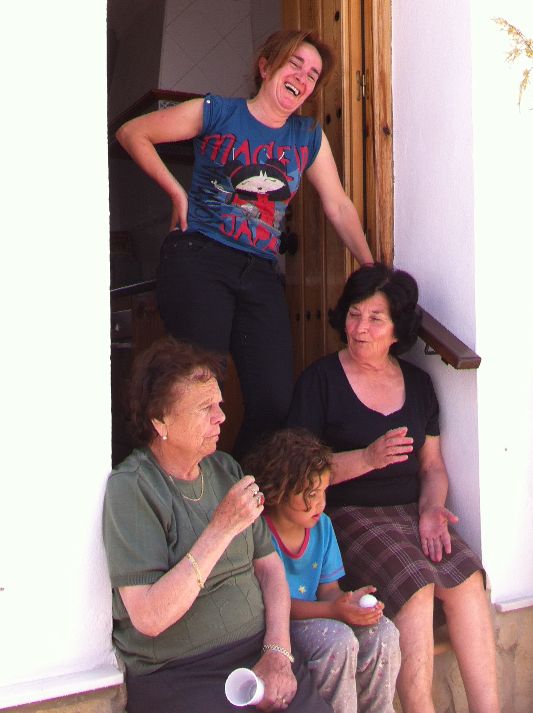 The other night as the cool air percolated down our little street and the kitchen chairs came out to balance precariously on the slope, she repeated the story to the other women. They laughed at me and added a string of abbreviated words to the list. Andao? Andado. Pagao? Pagado. Comprao? Comprado. Someone asked where Candelaria was. "Eta enca" came the reply. "Está en casa". The other night as the cool air percolated down our little street and the kitchen chairs came out to balance precariously on the slope, she repeated the story to the other women. They laughed at me and added a string of abbreviated words to the list. Andao? Andado. Pagao? Pagado. Comprao? Comprado. Someone asked where Candelaria was. "Eta enca" came the reply. "Está en casa".
So at night under the moon they teach me the language of the barrio, Spanish as she is really spoken. Next day in front of mi profe Juan-Mi I try out my new words, but I use the accent of the language school, the accent of Madrid. Progress, the coming together of all the strands of learning.
Another night Candelaria brings her chair to join us. She has an accent "thick enough to spread on toast" as Zafón wrote. She is kind to me, checks up on me, notices my brief visits back to England. "Are you here?" she invariably asks on my return. My "yes" seems inadequate, stating the obvious. Is the question somehow deeper than that? It's hard to ask what it is she really wants to know - my kindest neighbour, but kept distant by my lack of understanding.
Recently I met a friend inland a ways. Fluent to the point of teaching Tai-Chi in Spanish to Spaniards, he is comfortably a part of his adopted country. But just sometimes, he says, the one old chap in his street, the one that's really quite hard to understand, can feel like an effort too great to make. Guiltily, occasionally, he greets him with a quick "Buena!" and trots on by ensuring there is no opportunity for a slow and frustrating conversation. Sometimes, even when neighbours are kind, the effort feels too great. I share his guilt. I know, I too, have occasionally moved on quickly to avoid a question or a chat.
So Juan-Mi can teach me to avoid slang, colloquialisms, the language of the street. But the summer nights in the Rincón under the moonlight give me many things. Language, neighbours, friends, a sense of inclusion. And if Juan-Mi sighs when my accent slips towards Andaloo - well, so be it. It's our barrio and we'll eat peccao if we want to.
© Tamara Essex 2013
THIS WEEK’S LANGUAGE POINT:
Well, between a few of us we seem to have cracked the problem of "Se me da mal cocinar". I may not explain this very well, but it seems that we need the "Se" in this construction because the thing that goes badly is a verb. To cook. OR ... a noun that is acting as a replacement for a verb eg "Se me da mal la cocina" does not mean the kitchen is bad for me, but cooking. It's when it is some sort of activity. Similarly, "Se me dan mal las matematicas" is using the noun for maths, but as a replacement for the activity of DOING maths.
So as far as I can see, the "Se" is because it is sort of a reflexive verb ..... IT ( the cooking or the maths) is giving it bad to me. "Se me da mal cocinar" or "Se me da mal la cocina".
Not sure how clear that is as an explanation, but it had helped me get it clearer in my head. And now I have a bit of a reason for why it is the way it is, I can set that aside and just try and remember to use it!
 0
Like
Published at 4:51 PM Comments (9)
0
Like
Published at 4:51 PM Comments (9)
64 - Crossing Zafarraya
Friday, July 12, 2013
It’s different on the other side. It's still Spain, it's still Andalucía, but it’s just out of Málaga province and into Granada. And everything is different.

To get there, the road first goes south and round the bottom of Viñuela, that lovely body of water with its reflections and its mountainous backdrop. Gentle, picturesque, belying what comes later.
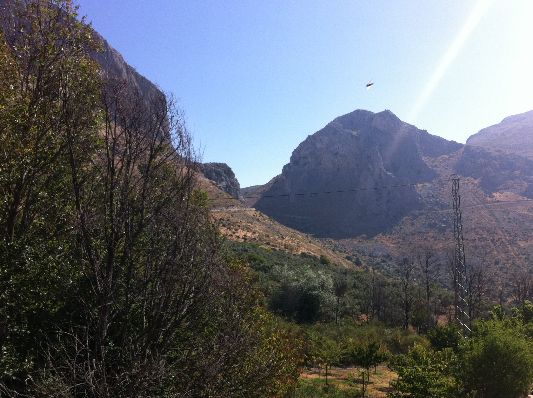 From there you climb, winding upwards, with views in all directions, pausing to marvel at the craggy rocks above. The great gap, the Zafarraya Pass, is in view, then disappears, teasing you and drawing you upwards around yet another bend. Higher, until there is nothing beside the road except rock and harshness. From there you climb, winding upwards, with views in all directions, pausing to marvel at the craggy rocks above. The great gap, the Zafarraya Pass, is in view, then disappears, teasing you and drawing you upwards around yet another bend. Higher, until there is nothing beside the road except rock and harshness.
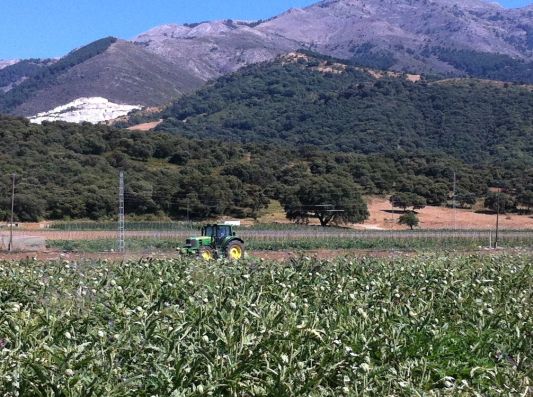 Suddenly without warning, you are through the gap. Ventas de Zafarraya, a small settlement, once important, then faded, now reviving through the success of the agricultural co-operative. It's blowy up there as you cross into Granada province. The gap creates a wind-tunnel from which there is no escape. Turning east out of the small town, the landscape opens. Big skies, huge flat agricultural lands, fertile due to sitting in a massive rock basin, but harsh, with no shelter. Suddenly without warning, you are through the gap. Ventas de Zafarraya, a small settlement, once important, then faded, now reviving through the success of the agricultural co-operative. It's blowy up there as you cross into Granada province. The gap creates a wind-tunnel from which there is no escape. Turning east out of the small town, the landscape opens. Big skies, huge flat agricultural lands, fertile due to sitting in a massive rock basin, but harsh, with no shelter.
 Miles of rows of vegetables. Warehouses, tractors, rough accommodation blocks for the seasonal labourers. Masses of activity under the blazing July afternoon sunshine. Very hot, very hard. Despite 60% unemployment amongst young people in Andalucía, this work is too tough for most, so others with extraordinary stamina travel from north Africa for 8-week stints to harvest the crops. They spend almost nothing while living in the huts, and take their hard-earned money home to their families across the Strait of Gibraltar. Miles of rows of vegetables. Warehouses, tractors, rough accommodation blocks for the seasonal labourers. Masses of activity under the blazing July afternoon sunshine. Very hot, very hard. Despite 60% unemployment amongst young people in Andalucía, this work is too tough for most, so others with extraordinary stamina travel from north Africa for 8-week stints to harvest the crops. They spend almost nothing while living in the huts, and take their hard-earned money home to their families across the Strait of Gibraltar.
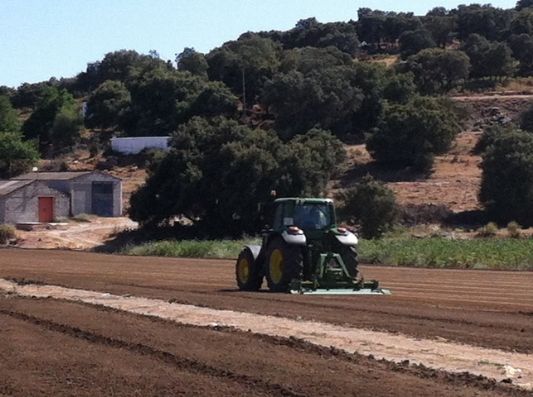 The tractors plough up and down, flicking sharp stones from under the wheels. The earth is not deep, but the underground water and the rich sediment provide sustenance - the crops are plentiful and the warehouses fill quickly. This area at an altitude of 1,000 metres has an extended season for vegetables, and the success of the HortoVentas co-operative of over 400 member farmers has ensured that the local population is increasing again, with other businesses springing up to supply the co-op’s ancillary needs. The tractors plough up and down, flicking sharp stones from under the wheels. The earth is not deep, but the underground water and the rich sediment provide sustenance - the crops are plentiful and the warehouses fill quickly. This area at an altitude of 1,000 metres has an extended season for vegetables, and the success of the HortoVentas co-operative of over 400 member farmers has ensured that the local population is increasing again, with other businesses springing up to supply the co-op’s ancillary needs.
Tomatoes, artichokes, cauliflower, beans, pepper, lettuce, cabbages, courgettes, chives and celery. Unusually nowadays, the vast majority of the crops are still grown outdoors, avoiding the “plastic city” areas popping up elsewhere (notably in 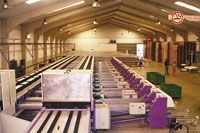 Almería), and delivering stronger flavours and colours which ensure the products are pre-ordered by buyers seeking the highest quality. In 2004 an increase in membership of the co-operative enabled a €1.6m investment - a new canning plant and better facilities for the employees and seasonal workers boosted productivity. HortoVentas is famous for its flavoursome, dark green tomatoes – over 7.5 million kilos produced annually. http://www.hortoventas.com/index.php/actualidad/27-video. The 400+ co-operative members are mostly small, specialist farmers, benefitting from the economies of scale of irrigation, machinery, marketing and distribution that the co-op offers. Almería), and delivering stronger flavours and colours which ensure the products are pre-ordered by buyers seeking the highest quality. In 2004 an increase in membership of the co-operative enabled a €1.6m investment - a new canning plant and better facilities for the employees and seasonal workers boosted productivity. HortoVentas is famous for its flavoursome, dark green tomatoes – over 7.5 million kilos produced annually. http://www.hortoventas.com/index.php/actualidad/27-video. The 400+ co-operative members are mostly small, specialist farmers, benefitting from the economies of scale of irrigation, machinery, marketing and distribution that the co-op offers.
After the flatlands the road winds on to Alhama de Granada, a wealthy town, the only one for miles. Hot springs led to Roman baths being established, followed by Arab baths in the 15th century. A spa hotel offers luxury treatments, while just outside it by the stream a pool accessible from the footpath offers a free (albeit rather public) hot spring experience. A third option is the Arab baths at El Ventorro, in a beautiful woodland setting. The dramatic gorge offers spectacular views – beautiful, yet at the same time emphasising the harsh cragginess of the landscape.
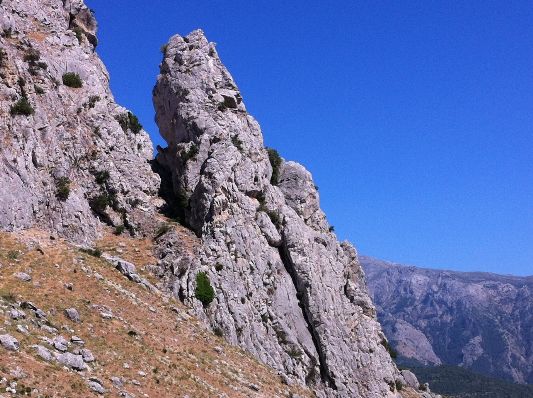
The drive back between the crops allows a closer look at the huge variety being grown. Then back through the pass. Looking downward over the rolling tree-covered Axarquía hills towards the touristy Mediterranean resorts it feels like a different world. Prettier. Easier. An easier life, this side of the Zafarraya Pass.
© Tamara Essex 2013
THIS WEEK’S LANGUAGE POINT:
I’m struggling this week. My teacher, Juan-Mi, is pushing me on those verbs that talk about your emotions and your abilities. I’m OK with “Me da miedo” (it frightens me, or literally “it gives me fear”), but cannot work out why sometimes it needs to be “Se me da mal cocinar” for example. “I’m rubbish at cooking”, or literally “Cooking gives it bad to me” or something like that! I suppose I just have to learn it, but I know I learn better when I can see a glimmer of logic, and this one has me stumped. Anyone got any tips for me on this?
 0
Like
Published at 12:15 AM Comments (4)
0
Like
Published at 12:15 AM Comments (4)
63 - Stalking .....
Thursday, July 4, 2013
 I seem to have become a stalker. Not the really really scary sort, I hope, but a bit of a stalker nonetheless. I seem to have become a stalker. Not the really really scary sort, I hope, but a bit of a stalker nonetheless.
I'm stalking these two women, Marianne and Molly. I'm stalking a bunch of guys as well, but only in the sense that I'm making plans and will get to them as soon as time and resources allow. But Marianne and Molly, one move from them and I'm there, right behind them, following their every step, camera at the ready.
I have them to thank for much of the pleasure that Andalucía has given me over the past year. They both write blogs about the area, and I rapidly learned to trust their judgement. The things they have loved, I too have loved. Where they suggest a visit, there I go. And always they have been right.
I found Marianne's blog first. Delightfully named "East of Málaga" she covers the same patch that I do, the lesser-known inland Axarquía region of Málaga province. A brilliant photographer, her vivid illustrations cannot help but grab the attention and immediately turn any reader into a stalker. Her first recommendation was of the delightful Arab baths in the woods outside Alhama de Granada. With two friends we followed Marianne's recommendations to the letter – and since then I was hooked. Her photos of Frigiliana astounded me - I hadn't known anywhere could be so cute - and I was there two days after her post was out. http://eastofmalaga.net/2012/01/27/photographs-i-love-and-why-part-9/
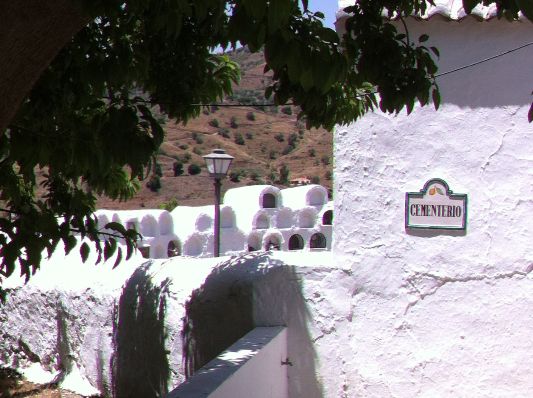 And then Sayalonga! The name of this little white village had long captivated me. So when earlier this month Marianne wrote about the unique circular cemetery and the narrowest street in the Axarquía, I closed the gap on her and got there the day after publication. I could almost picture her mass of blonde curls disappearing around a corner just ahead of me! Here’s the post that inspired me http://eastofmalaga.net/2013/06/15/death-in-the-afternoon-the-round-cemetery-of-sayalonga/ And then Sayalonga! The name of this little white village had long captivated me. So when earlier this month Marianne wrote about the unique circular cemetery and the narrowest street in the Axarquía, I closed the gap on her and got there the day after publication. I could almost picture her mass of blonde curls disappearing around a corner just ahead of me! Here’s the post that inspired me http://eastofmalaga.net/2013/06/15/death-in-the-afternoon-the-round-cemetery-of-sayalonga/
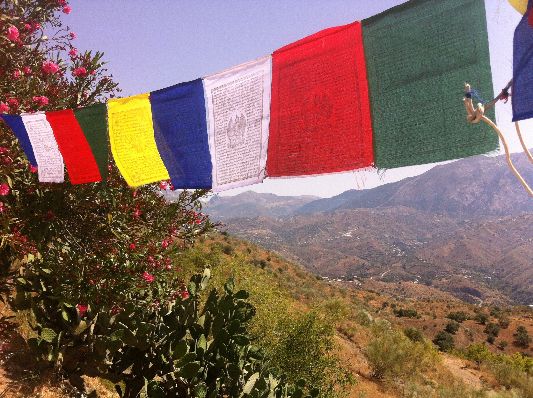 Last month she published photos of the extraordinary Buddhist Stupa, which I knew was near my home but I had never visited. The day after her blog was out, I was there. Ah! Did I catch a whiff of her scent on the breeze? Another superb recommendation. The Stupa Karachakra, up high in the mountains, is one of just four Stupas in the world and is an international focal point for Buddhists. Back down the mountain a little is the Karma Guen buddhist centre. Normally they show people around on Sundays, but the day I visited there was a weekend course, with two thousand impressively calm people camping, meditating, and listening to the Lama Ole whose presence for the weekend had drawn them there from across Europe. Last month she published photos of the extraordinary Buddhist Stupa, which I knew was near my home but I had never visited. The day after her blog was out, I was there. Ah! Did I catch a whiff of her scent on the breeze? Another superb recommendation. The Stupa Karachakra, up high in the mountains, is one of just four Stupas in the world and is an international focal point for Buddhists. Back down the mountain a little is the Karma Guen buddhist centre. Normally they show people around on Sundays, but the day I visited there was a weekend course, with two thousand impressively calm people camping, meditating, and listening to the Lama Ole whose presence for the weekend had drawn them there from across Europe.
Drop into Marianne's blog and enjoy her photos and you too may be inspired to follow in her footsteps! http://eastofmalaga.net/
At the same time last year I found Molly's blog. Based in Granada, her love for the city and its environs blazes from her words and ignites some of the same passion in the reader. She helps you navigate around the obvious popular sights, and equally sends you off into the lesser-known parts. The first blog post that had me reaching for the car keys was one about the belenes - the massive and complex nativity scenes built in churches and other buildings and squares around the city. I had no idea these things existed, and first explored the ones in Málaga (the blog post I wrote has one of my all-time favourite titles!) - http://tamaraessexspanishblog.wordpress.com/2012/12/22/37-gold-frankincense-and-wensleydale/ Then between Christmas and New Year I leapt in the car and followed her trail in Granada – here’s my post about it http://tamaraessexspanishblog.wordpress.com/2013/01/05/40-waitressing-in-granada/ and here’s Molly’s original that inspired me http://www.piccavey.com/nativity-scene-route-in-granada-ruta-de-belenes-2012/ Thanks to her, I have found parts of Granada I would never have found, and have come to love it almost as much as she does. My next visit there will include a pilgrimage to the newly-inaugurated Plaza Joe Strummer. Plus I need a large Moroccan wall-hanging, and thanks to Molly I know just where to look for one.
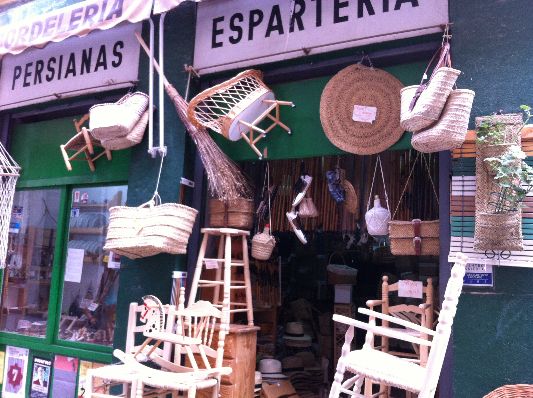 Nobody planning a trip to Granada (the city or the wider province) should do it without visiting Molly's blog first to soak up the atmosphere and add some locations to their itinerary. Find her at http://www.piccavey.com/ Nobody planning a trip to Granada (the city or the wider province) should do it without visiting Molly's blog first to soak up the atmosphere and add some locations to their itinerary. Find her at http://www.piccavey.com/
I hope you’ll have a look at their blogs. They continue to inspire me to travel around this beautiful area I am lucky enough to call home.
© Tamara Essex 2013
THIS WEEK’S LANGUAGE POINT:
I have many bad habits. But the one that Juan-Mi at http://www.axalingua.com/ is currently trying to drum out of me is that I seem to avoid the reflexive verbs. I keep asking “¿Es posible andar aquí?” Is it possible to walk here? Or “¿Está permitido andar aquí?” Is it permitted to walk here? Those are both sort of OK but not what a Spanish person would say. I should be asking “¿Se puede andar aquí?” Can one walk here? Similarly I keep saying “XYZ está usado …” XYZ is used. When I should say “se usa …”. Examples – “Se usa para cocinar” and “Se usa en la cocina”. It’s used for cooking. It’s used in the kitchen. Useful phrases for the ferretería (ironmongers).
 0
Like
Published at 10:09 PM Comments (3)
0
Like
Published at 10:09 PM Comments (3)
Spam post or Abuse? Please let us know
|
|